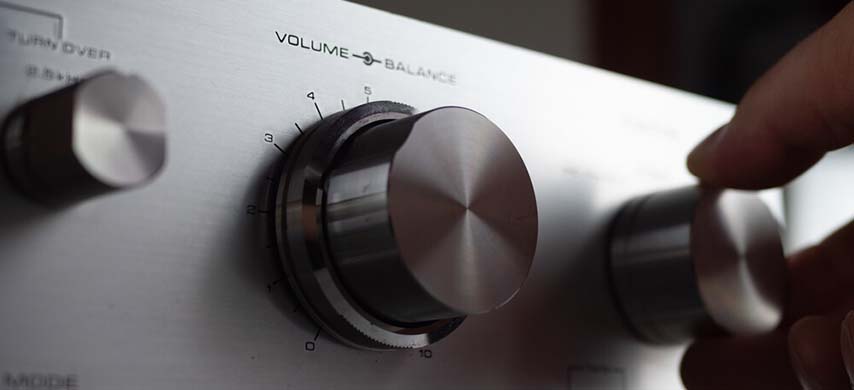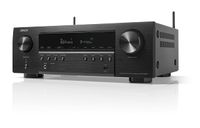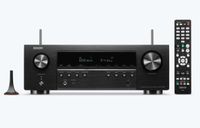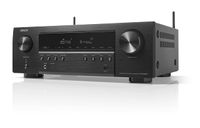What Is An Amplifier
 Electronics
ElectronicsAre you wondering what exactly an amplifier is and how it works? So are we! That's why our experts got this guide together to explore the basics of amplifiers. What it is, what are the classifications of amplifiers, why they're used, and some of the different types available.
If you're a tech beginner looking to get started with learning more about audio electronics or a pro searching for more knowledge, this guide is for you. Let's dive right in.
What Is An Amplifier
An amplifier is an electronic device designed to increase the strength or amplitude of a signal. In the context of audio systems, audio power amplifiers are used to enhance the power of audio signals, making them stronger and capable of driving speakers or headphones to produce sound at higher volumes.
Amplifiers work by taking a weak input signal and using electronic components like transistors or vacuum tubes to boost their voltage, current, or power level. This amplified signal is then sent to an output, usually to a speaker or another audio device, where it is converted into audible sound.
Types Of Amplifiers
They are different types of amplifiers. Each type of amplifier serves a specific purpose and caters to different applications. Here are the most common ones:
- Audio Amplifiers: These are the most common type of amplifiers used in audio systems. They increase the power of low-level audio signals from sources like microphones, musical instruments, and audio playback devices, making them suitable for driving speakers or headphones.
- Power Amplifiers: These amplifiers are designed to provide the necessary power to drive speakers, ensuring that the audio signals are transformed into sound with sufficient volume. They are commonly used in home theater systems, stereo setups, and live sound applications.
- Voltage Amplifiers: Voltage amplifiers are a type of amplifier that primarily focuses on increasing the voltage level of an input signal while maintaining its shape and frequency. These amplifiers are commonly used in applications where the amplitude of the signal needs to be boosted without significantly affecting other signal characteristics.
- Operational Amplifiers (Op-Amps): Op-amps are versatile amplifiers used in a wide range of electronic circuits. They are often used for signal conditioning, amplification, filtering, and other signal-processing applications. Op-amps have high gain and are often used as building blocks for more complex electronic circuits.
- Radio Frequency (RF) Amplifiers: RF amplifiers are used to amplify radio frequency signals, which are crucial in communication systems, radio broadcasting, wireless technologies, and radar systems. RF amplifiers are designed to operate at high frequencies and often require specialized circuitry.
- Instrumentation Amplifiers: These amplifiers are used to amplify small differential signals, often encountered in measurement and sensor applications. They offer high common-mode rejection and accurate amplification of weak signals.
- Class A Amplifiers: Amplifier classes refer to the different operational modes and efficiency characteristics of amplifiers based on how the output devices handle the input signal. Class A amplifiers operate by allowing a constant current to flow through the output transistors, resulting in minimal distortion. While they provide high-quality sound, they are less efficient and generate more heat.
- Class B Amplifiers: Class B amplifiers use a push-pull configuration of output transistors to increase efficiency. However, they can introduce distortion due to the transition between the positive and negative halves of the input waveform.
- Class AB Amplifiers: These amplifiers combine features of Class A and Class B designs. They use both positive and negative half-cycles of the input waveform, improving efficiency while reducing distortion compared to pure Class B amplifiers.
- Class D Amplifiers: Also known as switching amplifiers, Class D amplifiers use digital switching techniques to rapidly switch the output devices on and off. They are highly efficient and generate less heat, making them suitable for portable devices and subwoofers.
- Differential Amplifiers: These amplifiers amplify the difference between two input signals while rejecting common-mode signals. They are commonly used in applications where noise rejection and precision amplification are essential.
- Guitar Amplifiers: Designed specifically for electric guitars, these amplifiers enhance the sound characteristics of the instrument. They often come with tone-shaping controls and effects to create a desired sound.
- Integrated Amplifiers: These combine preamplifier and power amplifier functions into a single unit, simplifying the setup process. They are commonly used in stereo systems and offer a convenient all-in-one solution.
How Does An Amplifier Work?
An amplifier is an electronic device that increases the amplitude of an input signal to produce a larger output signal. It plays a crucial role in various fields, from audio systems and communication networks to scientific instruments and industrial applications.
Components of an Amplifier: An amplifier typically consists of three main components: the input stage, the amplification stage, and the output stage. The input stage receives the weak input signal and prepares it for amplification.
The amplification stage, composed of active components like transistors or tubes, significantly boosts the signal's amplitude. Finally, the output stage delivers the amplified signal to the load, such as speakers or another circuit.
Working Principles: Amplifiers operate based on the principles of signal amplification and feedback control. Here's a step-by-step breakdown of how they work:
- Input Stage: The input signal, which is often small and weak, is fed into the amplifier. The input stage prepares the signal for amplification by matching its impedance, biasing the active components, and often converting the signal into a form that's suitable for the amplification stage.
- Amplification Stage: The heart of the amplifier lies in the amplification stage, where active components like transistors or tubes are used. These components control the flow of current based on the input signal. In a transistor-based amplifier, for example, a small input current controls a larger current flowing between the collector and emitter terminals.
- Voltage Gain: Amplifiers provide voltage gain, where the input voltage is multiplied to create a larger output voltage. This gain is determined by the properties of the active components and their arrangement within the circuit.
- Current Gain: In addition to voltage gain, amplifiers also provide current gain. This means that a small input current can control a larger output current, thus driving the load with sufficient power.
- Feedback Mechanism: To ensure stability and precise amplification, many amplifiers employ feedback mechanisms. Negative feedback uses a portion of the output signal to correct and stabilize the amplification process. This minimizes distortion and ensures consistent performance across different frequencies.
- Output Stage: The amplified signal is then passed to the output stage, which further prepares it for delivery to the load. This stage is responsible for matching the output impedance of the amplifier with the impedance of the connected load to maximize power transfer.
Preamp vs. Power Amp
Preamp and power amplifiers are important elements in audio systems, but they serve different functions in processing and amplifying audio signals.
Understanding their roles can help you create a better audio setup tailored to your purpose.
Preamp:
- Function: The preamplifier, often called a preamp, is the initial stage of signal processing in an audio system. It's responsible for taking weak audio signals from sources like microphones, instruments, or playback devices and boosting them to a level that can be further processed and amplified.
- Signal Processing: Preamps can adjust the input signal's volume, tone, and equalization. They also provide features like input selection, balance, and switching between different sources. Some preamps have built-in features like phono stages for turntables or headphone amplifiers.
- Low-Noise Amplification: Preamps are designed to provide clean and accurate amplification without adding significant noise to the signal. They ensure that the signal remains strong and clear throughout the audio chain.
Power Amplifier:
- Function: The power amplifier takes the processed audio signal from the preamp and amplifies it to a level suitable for driving speakers. It provides the necessary power to move the speaker drivers and produce audible sound.
- Amplification: Power amplifiers can significantly increase the amplitude of the audio signal without altering its content. They have the capability to deliver high currents and voltage to the speakers, translating the electrical signal into sound waves.
- Speaker Matching: Different speakers have varying impedance and power requirements. Power amplifiers need to match the speaker's impedance and power handling to ensure optimal performance and prevent damage to both the amplifier and speakers.
How To Choose the Right Custom Amplifier
Choosing the right custom amplifier can help to achieve the best audio experience tailored to your needs and preferences.
Here are some key factors to consider before making your purchase:
- Purpose and Application: Determine the purpose of the amplifier. Are you using it for home audio, live performances, recording, or studio work? The application will influence the features and specifications you need.
- Power Output: Consider the power output of the amplifier, often measured in watts per channel. This determines how loud and clear your audio will be. Make sure the amplifier can provide sufficient power for your speakers without distortion.
- Speaker Compatibility: Ensure that the amplifier's power and impedance ratings match your speakers. Mismatched impedance can damage the amplifier and speakers, affecting audio quality.
- Audio Quality: Look for amplifiers with low distortion and high signal-to-noise ratios. A clean and accurate amplification ensures faithful reproduction of your audio sources.
- Number of Channels: Decide how many channels you need. Stereo amplifiers have two channels, suitable for basic setups. If you're dealing with surround sound or multiple speakers, you may need more channels.
- Connectivity Options: Check the available inputs and outputs. Modern amplifiers offer various connection options, including analog, digital, and wireless. Ensure compatibility with your audio sources.
- Features and Controls: Consider the features you need, such as tone controls, EQ adjustments, balance, and volume. Some amplifiers come with built-in effects, headphone outputs, and input selectors.
- Build Quality: Opt for amplifiers with solid construction and durable components. Well-built amplifiers tend to last longer and provide better reliability.
- Size and Portability: Consider the size and weight of the amplifier, especially if you plan to move it around. Portable amplifiers are suitable for gigs or events.
- User-Friendly Interface: Choose an amplifier with intuitive controls and an easy-to-navigate interface. This ensures a hassle-free operation, especially for beginners.
Best Sony Receiver:
According to our experts, you can experience cinematic sound right at home with the Sony STR-DH790 7.2-ch Surround Sound AV Receiver. The quality audio of Dolby Atmos and DTS:X creates a multi-dimensional surround sound experience.
The 4K quality with HDR pass-through supporting Dolby Vision, HDR10, and Hybrid Log Gamma gives vivid color and contrast. Connect effortlessly with multiple HDMI and audio connections. The advanced D.C.A.C. calibration ensures optimal audio in every room, while Bluetooth standby and low-profile design add convenience.
Best Amplifier:
Transform your home entertainment with the Denon AVR-S760H 7.2 Ch AVR. Embrace the future with its 8K-ready performance, supporting the latest 3D audio formats like Dolby Atmos Height Virtualization and DTS: X.
Our experts find the advanced HDMI video section with 8K upscaling ensures stunning visuals while versatile connections, intuitive setup, and Japanese precision technology make this AVR a must-have for your home theater. You can enjoy music throughout your home with HEOS wireless speakers and achieve effortless control with voice agents like Alexa.
Best Renewed Offer:
The Denon AVR-S760H 7.2-Channel Home Theater AV Receiver is now available in renewed condition. You can experience the power of 8K Video Ultra HD and 4K/120 capabilities.
This product has been meticulously inspected, tested, and cleaned by certified vendors. It's in great condition and free from cosmetic damage and boasts batteries with over 80% capacity. Though accessories may not be original, they're fully functional.
Best Denon Offer:
Our experts find you can elevate your audio experience with the Denon AVR-S660H 5.2 Ch AVR. This 2021 model redefines your entertainment setup, offering a seamless blend of innovation and performance.
Gamers can appreciate the lag-free experience thanks to Variable Refresh Rate, Quick Frame Transport, and Auto Low Latency Mode. Plus, enjoy the convenience of wireless streaming with HEOS Multi-Room speakers and full voice control compatibility.
Now that you crossed over to the technology geek road, you are one of us, and you know everything there's to know about amplifiers. You can select the perfect one for your needs and purpose and feel the power of audio. It's all about the bass!




